
Canada, the world's second-largest country in total area, is dedicated to having an efficient, high-capacity multimodal transportation spanning often vast distances between natural resource extraction sites, agricultural and urban areas. Canada's transportation system includes more than 1,400,000 kilometres (870,000 mi) of roads, 10 major international airports, 300 smaller airports, 72,093 km (44,797 mi) of functioning railway track, and more than 300 commercial ports and harbours that provide access to the Pacific, Atlantic and Arctic oceans as well as the Great Lakes and the St. Lawrence Seaway. In 2005, the transportation sector made up 4.2% of Canada's GDP, compared to 3.7% for Canada's mining and oil and gas extraction industries.
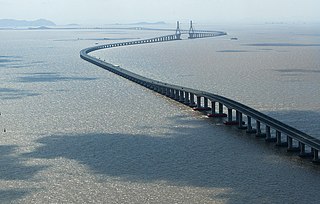
Transport in China has experienced major growth and expansion in recent years. Although China's transport system comprises a vast network of transport nodes across its huge territory, the nodes tend to concentrate in the more economically developed coastal areas and inland cities along major rivers. The physical state and comprehensiveness of China's transport infrastructure tend to vary widely by geography. While remote, rural areas still largely depend on non-mechanized means of transport, urban areas boast a wide variety of modern options, including a maglev system connecting the city center of Shanghai with Shanghai Pudong International Airport. Airports, roads, and railway construction will provide a massive employment boost in China over the next decade.

Nanchang is the capital of Jiangxi Province, People's Republic of China. Located in the north-central part of the province and in the hinterland of Poyang Lake Plain, it is bounded on the west by the Jiuling Mountains, and on the east by Poyang Lake. Because of its strategic location connecting the prosperous East and South China, it has become a major railway hub in Southern China in recent decades.

The Ministry of Finance of the People's Republic of China is the constituent department of the State Council of the People's Republic of China which administers macroeconomic policies and the annual budget. It also handles fiscal policy, economic regulations and government expenditure for the state.
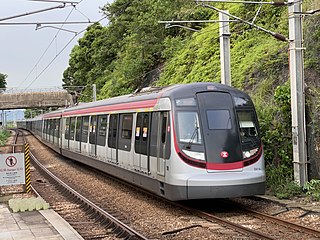
The East Rail line is one of the ten lines that form MTR, the mass transit system in Hong Kong. The railway line starts at Lo Wu or Lok Ma Chau, both of which are boundary crossing points into Shenzhen and joins in the north at Sheung Shui and ends at Admiralty station on Hong Kong Island. At approximately 45.8 km (28.5 mi), the line is the second longest line within the network, behind the Tuen Ma line. The line's colour is light blue.

The National Police Agency, Ministry of the Interior is an agency under the Ministry of the Interior of the Republic of China (Taiwan). The agency oversees all police forces on a national level, and is headquartered in Taipei.

The National Medical Products Administration is a national bureau responsible for drug supervision under the State Council of China and is managed by the State Administration for Market Regulation.

The Maritime Safety Administration of the People's Republic of China is a government agency which administers all matters related to maritime and shipping safety, including the supervision of maritime traffic safety and security, prevention of pollution from ships, inspection of ships and offshore facilities, navigational safety measures, administrative management of port operations, and law enforcement on matters of maritime safety law. It was also responsible for marine accident investigation. It is headquartered in Dongcheng District, Beijing.
The telecommunications industry in China is dominated by three state-run businesses: China Telecom, China Unicom and China Mobile. The three companies were formed by restructuring launched in May 2008, directed by the Ministry of Information Industry (MII), National Development and Reform Commission (NDRC) and the Minister of Finance. Since then, all three companies gained nationwide fixed-line and cellular mobile telecom licenses in China. In 2019, all three telecoms were issued 5G national licenses.

Sinosteel Corporation is a state-owned enterprise, primarily in mining, trading, equipment manufacturing and engineering. Founded in 1993 and based in the People's Republic of China, it is the country's second largest importer of iron ore. The company used to be under the direct supervision of the State-owned Assets Supervision and Administration Commission. In 2022, it was acquired by state-owned steel conglomerate Baowu.
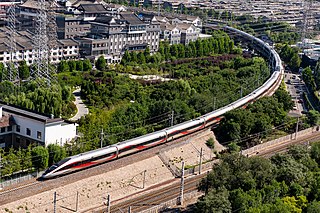
The high-speed rail (HSR) network in the People's Republic of China (PRC) is the world's longest and most extensively used – with a total length of 42,000 kilometres (26,000 mi) by the end of 2022. The HSR network encompasses newly built rail lines with a design speed of 200–350 km/h (120–220 mph). China's HSR accounts for two-thirds of the world's total high-speed railway networks. Almost all HSR trains, track and service are owned and operated by the China Railway Corporation under the brand China Railway High-speed (CRH).
The Norwegian National Rail Administration was a government agency responsible for owning, maintaining, operating and developing the Norwegian railway network, including the track, stations, classification yards, traffic management and timetables. Safety oversight was the duty of the Norwegian Railway Inspectorate, while numerous operating companies run trains on the lines; the largest being the state owned passenger company Vy and the freight company CargoNet.
Shenhua Group Corporation Limited was a Chinese state-owned mining and energy company. Shenhua Group was founded in October 1995 under the auspices of the State Council of the People's Republic of China. It was the largest coal-producing company in China. In 2014 Shenhua Group produced 437 million tonnes of coal and sold 588 million tonnes of coal. In 2014, Shenhua Group's revenue was 328.6 billion yuan, and the company ranked 196th in the Global Fortune 500. The same year the Shenhua Group's profit was 64 billion yuan. On August 28, 2017, SASAC announced that China Guodian Corporation and Shenhua Group would be jointly restructured, with Shenhua Group becoming China Energy Investment Corporation and absorbing China Guodian Corporation.

Food safety in China is a widespread concern for the country's agricultural industry. China's principal crops are rice, corn, wheat, soybeans, and cotton in addition to apples and other fruits and vegetables. China's principal livestock products include pork, beef, dairy, and eggs. The Chinese government oversees agricultural production as well as the manufacture of food packaging, containers, chemical additives, drug production, and business regulation. In recent years, the Chinese government attempted to consolidate food safety regulation with the creation of the State Food and Drug Administration of China in 2003; officials have also been under increasing public and international pressure to solve food safety problems. Chinese Vice Premier Li Keqiang said, "Food is essential, and safety should be a top priority. Food safety is closely related to people's lives and health and economic development and social harmony," at a State Council meeting in Beijing.
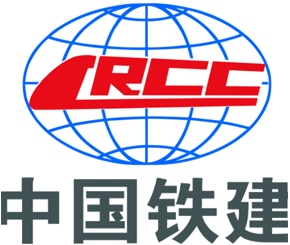
China Railway Construction Corporation Limited is a listed construction enterprise based in Beijing, China, that was the second largest construction and engineering company in the world by revenue in 2014.

The Ministry of Economic Affairs is the ministry of the Republic of China (Taiwan) responsible for formulating policy and laws for industry and trade, foreign direct investment, energy, minerals, measurement standards, intellectual property, state-owned enterprises. The ministry is a cabinet level government agency of the Executive Yuan.

The Al Mashaaer Al Mugaddassah Metro Line, (Arabic: قطار المشاعر المقدسة الخط الجنوبي qtar al mashaaer al muqaddassah al khat diljanubi) is a metro line in the city of Mecca, Saudi Arabia. Claimed to have the highest capacity of any metro in the world, it operates for seven days a year, and is used exclusively as a shuttle train for pilgrims between holy sites in Mecca, Mount Arafat, Muzdalifah and Mina to reduce congestion caused by thousands of buses and cars during the Hajj. It is the second metro system on the Arabian Peninsula, after the Dubai Metro.
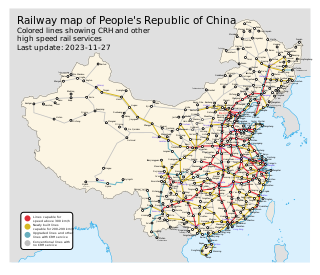
Rail transport is an important mode of long-distance transportation in China. As of 2021, the country had more than 155,000 km (96,313 mi) of railways, the second longest network in the world. By the end of 2022, China had more than 42,000 kilometres of high-speed rail (HSR), the longest HSR network in the world.
The administrative structure of the government of the Empire of Japan on the eve of the Second World War broadly consisted of the Cabinet, the civil service, local and prefectural governments, the governments-general of Chosen (Korea) and Formosa (Taiwan) and the colonial offices. It underwent several changes during the wartime years, and was entirely reorganized when the Empire of Japan was officially dissolved in 1947.

The State Administration for Market Regulation is a Chinese ministerial-level agency directly under the State Council of the People's Republic of China responsible for comprehensive market supervision and management.


















